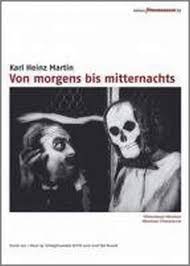
When a foreign woman (Erna Morena) comes to the bank to withdraw 10,000 marks the bank manager (Eberhard Wrede) denies the request. The woman doesn’t have proper authorization for the withdrawal. While she is at the bank her son (Hans Heinrich von Twardowski) is at a thrift shop trying to purchase a picture for 10,000 marks. The bank cashier (Ernst Deutsch) is captivated by the woman. She comes back trying to use her diamond bracelet as collateral but she goes away empty handed. The cashier thinks about his life with his mother (Frieda Richard), his wife (Lotte Stein) and his daughter (Roma Bahn). He bemoans the fact that his station in life is of a poor lowly cashier in a bank full of money.
When a beggar woman (Erna Morena) comes to the bank he sees her as death. The cashier decides that life is too short to be poor, so he steals a huge amount of money from the bank. He goes to the foreign woman and offers her money and himself. She laughs at him. Then he finds out that she has a son. Realizing he still looks like a low life in her eyes despite having money he leaves dejected.
The cashier goes home and, despite being surrounded by a loving family, is feeling more depressed about his life. Abandoning his family, the cashier goes to a big city, buys a new set of clothes and starts spending his ill-gotten gains. He attends a six-day bicycle race and starts gambling and offering prize money. When a Prince arrives, the mood gets subdued. By now the cashier is thriving on the status that money gives him. He continues to look for outside stimulus and happiness but is continually finding out that what he is looking for is still out of reach. The only thing that is continual in his life is that death is always nearby.
“From Morn to Midnight” AKA “Von morgens bis mitternachts” was released in 1920 and was directed by Karl Heinz Martin. It is a silent German Expressionistic film. The movie is based on the play “From Morning to Midnight” by George Kaiser. The film is presented in five acts. The art direction and costume design were done by Robert Neppach. Reportedly the movie never had a German release but was popular in Japan. At one time the film was believed to have been lost. A copy was found in 1963 in Japan and was restored.
The movie is full blown German Expressionism. The sets are overly simplistic yet exaggerated. Sharp lines are used on stark distorted sets with dark shadowed areas surrounding the action. Even the wardrobe and makeup are exaggerated and primitive. The plot of the film is simple and unremarkable but the way it is depicted is what makes the film interesting. Even the characters are plain. None of them have names.
The film raises some questions. The picture that the lady wants to buy is an impressionistic nude. Is she the subject that the artist painted? When the cashier sees the picture, he envisions the expressionistic painting as an actual nude. Does he believe that the painting is the lady? The whole painting thing isn’t explained and left me thinking I missed something important in the film.
There’s also a mock crucifixion scene that make some believe that the film is a stylized portrayal of the Stations of the Cross. Also, the fact that death is always portrayed as a woman and is played by the same actress, although in different roles, may have meaning. I didn’t understand any of this either but then I probably missed a lot.

